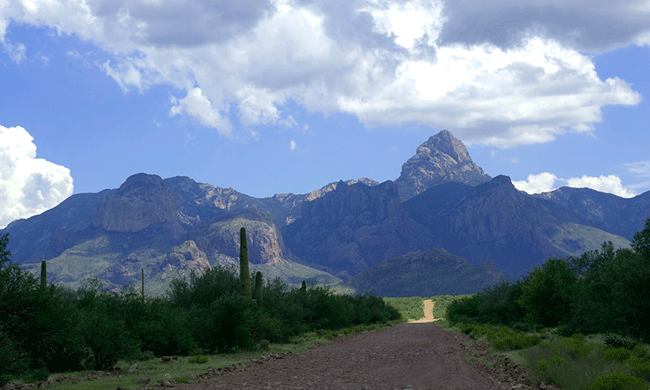
by Deep Green Resistance News Service | Nov 24, 2016 | Indigenous Autonomy
by Tristan Ahtone / Yes Magazine
President-elect Donald Trump says that he will build a wall along the U.S.-Mexico border. It will stop undocumented immigrants from entering the country. It will stop drugs from entering the country. It will be 50 feet tall. It will be nearly a thousand miles long. And it will cut the traditional lands of the Tohono O’odham Nation of Arizona in half.
The Tohono O’odham reservation is one of the largest in the nation, and occupies area that includes 76 miles of the U.S.-Mexico border. However, the tribe’s traditional lands extend deep into Mexico, and tribal members live on both sides of the border: With tribal identification, they cross regularly to visit family, receive medical services, and participate in ceremonial or religious services.
The prospect of slicing their homelands in two? Not welcome.
“Over my dead body will a wall be built,” says Verlon Jose, vice chairperson of the Tohono O’odham Nation. “If he decides to build a wall, he’s going to need to come talk to us, unless he wants to see another Standing Rock.”
In other words, to build the wall, Mr. Trump will have to fight for every single mile of Tohono O’odham land—legally, and possibly even physically.
And they’re not the only tribal nation that would be impacted by the wall.
Robert Holden, deputy director of the National Congress of American Indians, points to the Ysleta Del Sur in Texas and tribes in California, such as the Kumeyaay, who have relatives in Mexico. “There’s significant tribal sovereignty at stake here,” Holden says.
Currently, a vehicle barrier on Tohono O’odham land separates Mexico from the United States. It’s stopped cars and trucks from crashing across the border but hasn’t significantly curbed illegal activities in the area.
The nation sits inside what the Department of Homeland Security calls the Tucson Sector—262 miles of border stretching from New Mexico almost entirely across Arizona, and one of the busiest areas for illegal border activity in the U.S. In 2015, more than 60,000 pounds of marijuana, cocaine, methamphetamine, and heroin were seized by Tucson Border Patrol. According to officials, that same year, Border Patrol handled more than 2,100 drug cases, and some 680 smuggling cases were prosecuted out of the Tucson Sector.
But despite the statistics, the Tohono O’odham have resisted more intrusive physical barriers within their territory.
“The people of the Tohono O’odham Nation have always been against a wall,” says Jose. In the 1990s, he adds, federal agencies discussed a wall or some other additional security barrier, but the tribe resisted, and the plan was dropped.
In order to deal with criminal activities in the area, the nation has opted to work with the Department of Homeland Security, U.S. Immigration and Customs Enforcement, as well as Border Patrol. For instance, the Shadow Wolves—a Tohono O’odham tactical patrol unit—have worked with DHS since the early 2000s and are responsible for seizing thousands of pounds of illegal drugs and for hundreds of arrests on the reservation. And tribal law enforcement has worked closely with federal authorities as well as tribal communities to maintain a semblance of safety and order.
This doesn’t mean things are peachy down on the Tohono O’odham reservation, though: Tribal members say they are routinely harassed by Border Patrol; cultural and religious items are frequently confiscated; and detentions and deportations of tribal citizens are not uncommon. In 2014, two tribal members were hospitalized after being shot by a Border Patrol agent. The situation has often been compared to a Berlin Wall-like scenario, but the tribe has fought for and maintained the ability to enjoy its traditional homelands—at least more than if a wall were running through the middle of it.
“Let me come into your home and build a wall directly in the middle of your house and tell me what impacts that would have on you?” says Jose. “This land is our grocery store; this land is our medical facility, where we get our medicinal remedies from; this land is our college and university. Our sacred sites are in Mexico; our ceremonies are in what is now Mexico. The border is an imaginary line to us.”
Border Patrol officials declined to comment on the proposed wall or how the agency has worked with the Tohono O’odham in the past.
“Beyond the practical difficulties of building and maintaining such a wall, it really would undermine a lot of cooperative agreements that law enforcement rely on to police that border,” says Melissa Tatum, a law professor at the University of Arizona. “If they’re not cooperating with the Tohono O’odham that help to secure the border, it creates incentives to have more resistance.”
In the short term, when it comes to securing the border, there are no easy answers or solutions. But when it comes to working with tribal nations on the issue, in the eyes of the Tohono O’odham, Trump’s proposed wall represents either gross ignorance or blatant disregard for tribal sovereignty. And if construction begins, it could signal the winding back of clocks on U.S.-tribal relations on the border.
“I can’t even imagine how far it would set us back,” says Tatum. “More than a hundred years.”
Tristan Ahtone wrote this article for YES! Magazine. Tristan is a journalist and member of the Kiowa tribe of Oklahoma. His work has appeared on and in PBS NewsHour, National Native News, Frontline, Wyoming Public Radio, Vice, Fronteras Desk, NPR, and Al Jazeera America.
This article has been re-published Deep Green Resistance News Service under a Creative Commons License.
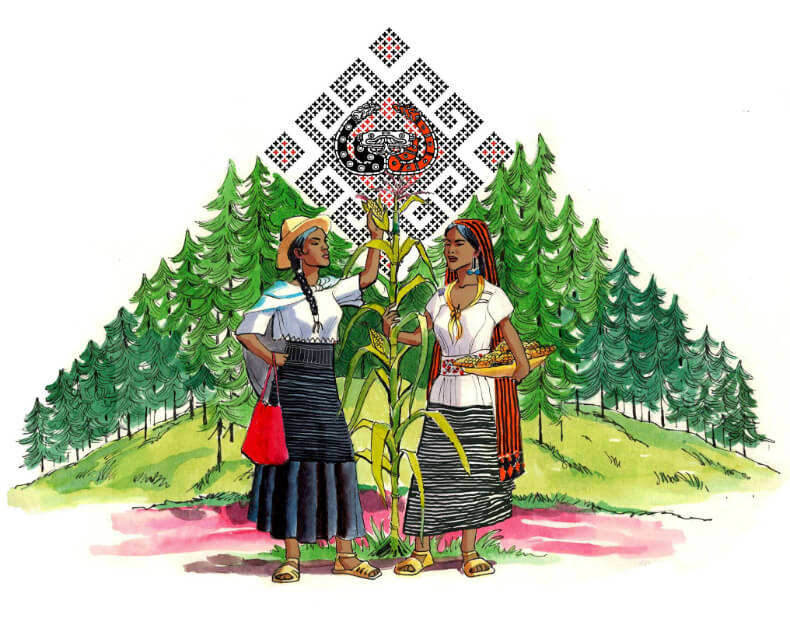
by Deep Green Resistance News Service | Oct 18, 2016 | Indigenous Autonomy
by Emmy Keppler / Intercontinental Cry
On October 13, the 500 delegates of the National Indigenous Congress (CNI) reached complete consensus on the proposal presented by the Zapatista Army of National Liberation (EZLN) at the opening of the fifth Congress three days earlier: the CNI will collectively enter the 2018 Mexican presidential race with an indigenous woman candidate at its forefront.
The Fifth Congress is now in permanent assembly while the delegates return to their communities and hold consultations to decide to either approve or reject the proposal.
This decision represents a major shift in strategy of the Zapatista movement which in 2003, after nine years of betrayed negotiations with the Mexican government, cut off all communication with the political system. In the subsequent thirteen years they have not looked back, focusing instead on constructing autonomy in their own communities. The proposed presidential campaign will not, however, be a return to engagement with the political system, but rather a takeover and, if successful, dismantling of that system.
“We confirm that our fight is not for power, we do not seek it; rather we call all of the original peoples and civil society to organize to detain this destruction, to strengthen our resistances and rebellions, that is to say in the defense of the life of each person, family, collective, community, or neighborhood. To construct peace and justice, reconnecting ourselves from below,” stated the CNI and EZLN in a communiqué released at the closure of the assembly.
The Indigenous Council of Government will be made up of representatives from CNI communities from all states and regions of Mexico, with the individual candidate serving to “make their [collective] word material.”
THE FIGHT FOR RECOGNITION
The CNI was formed in 1996, nearly two years after the indigenous Zapatistas of Chiapas famously rose up in arms and declared war on the Mexican government. Earlier that same year, the EZLN and federal government signed the San Andrés Accords, which agreed to recognize indigenous autonomy in the constitution, increase indigenous political representation, and guarantee access to justice.
In October of that year, thousands of indigenous people from communities all over the country gathered in Mexico City for the first National Indigenous Congress, agreeing that their primary objective would be to defend the San Andrés Accords. It was at this first Congress that the late EZLN commander Ramona declared what soon became the slogan of the CNI: “NEVER AGAIN A MEXICO WITHOUT US.”
When the EZLN and government met to finalize the Accords one month later, a familiar pattern of denial began to re-emerge: The government refused to sign the Accords. Simultaneously, then president Ernesto Zedillo launched a bloody militarization campaign throughout Chiapas climaxing in the Acteal Massacre in which paramilitary troops massacred 45 members of Las Abejas, an indigenous Catholic pacifist organization.
The primary focus of both the EZLN and the CNI, then, became an effort to push the Mexican government to pass the Accords. In 2001, the third National Indigenous Congress was held in the Purépucha community of Nurío in Michoacán. Representatives from 40 of Mexico’s 57 Indigenous Peoples created a list of demands including constitutional recognition of indigenous rights and autonomy, and the recognition of indigenous systems of justice and ancestral territory.
That same year, Comandanta Esther addressed the Congress of the Union: “When indigenous rights and culture are constitutionally recognized in accord with the [San Andrés Accords], the law will begin joining its hour with the hour of the Indian peoples.”
The following month, Congress unanimously approved a constitutional reform concerning indigenous rights and culture that ignored all demands for autonomy and recognition, completely undermining the San Andrés Accords and cementing the betrayal of Indigenous Peoples by the entire Mexican political system.
It was after this ultimate betrayal that the Zapatistas and CNI decided to turn their backs on the Mexican political system which refused to include them. Instead, they decided to take matters in their own hands and implement the San Andrés Accords themselves in their communities and territories. What the government refused to give them, they would build.
For the next thirteen years, the Zapatista communities of Chiapas and indigenous communities throughout Mexico worked to construct their own autonomy from the ground up.
ACHIEVEMENTS AND LIMITATIONS OF AUTONOMY
In this Fifth National Indigenous Congress, which also celebrated the 20th anniversary of the CNI, delegates shared the immense achievements of autonomy in their communities:
They have rebuilt their traditional farming structures using organic fertilizers and native seeds.
They have reconstituted their traditional governments, replacing the corrupt government authorities with elder councils and community assemblies.
They have built their own community police and self defense forces, ousting organized crime and replacing the similarly corrupt official police who often work with narcotraffickers.
They have created community radio stations to broadcast the truth, drowning out the lies and silence of corporate media which, in Mexico, is monopolized by the media empire Televisa.
They have recuperated territory that was violently expropriated by the government and large landowners.
They have created their own bilingual indigenous schools where students learn about colonialism, capitalism, and the history of their people.
They have revived their traditional medicine and built clinics where before people had no healthcare, fighting dependence on western medicine.
However, they have also faced extreme repression, plunder of their territories, and human rights violations. There was not a single community that did not speak of their fight against what they call ‘death projects’— mining, fracking, hydroelectric dams, gas pipelines, airport construction, highway construction — operated by foreign corporations which do not consult their communities before destroying their land.
They are fighting against agroindustrial chemicals and pesticides contaminating their land and waters, the destruction of their forests, the invasion of genetically modified seeds, and the privatization and expropriation of their sacred water and collectively-held territory.
They are fighting supposedly ‘green’ development in the form of wind farms and conservation reserves that expropriate their territory and farmland, often for the production of monocrops like African Palm.
They are fighting against cultural death— the tourism industry that pillages their sacred sites and perverts their traditions as attractions for foreigners, and the disappearance of their languages and clothing.
And they are fighting against literal death—the murder, disappearance, kidnapping, rape, imprisonment, and psychological warfare that all indigenous communities in resistance face at the hands of the military, police, and organized crime.
The nation is also on the brink of total privatization of the public sector with the 11 structural adjustments passed by President Enrique Peña Nieto in 2013. Though the the CNI can prevent these reforms from entering their communities on a certain level, they can not, through autonomy alone, halt the devastating impacts of the privatization of public healthcare, education, communication, energy, and housing, among others.
In this Fifth Congress, the delegates recognized that walking the path of autonomy, though remarkably successful on a local level, has not allowed the Indigenous Peoples of Mexico to truly unite. Building coalitions on statewide and even regional or municipal levels has proved exceedingly difficult with most communities remaining relatively isolated. Though they all face the same repression by corporations and the government, each community fights the same enemy from its different corner of Mexico, thus allowing what the Zapatistas call ‘the capitalist hydra’ to divide and conquer. As one delegate from Jalisco said, “they’re continuing to screw us.”
THE PROPOSAL
The proposal of the EZLN for the CNI to run a collective presidential campaign is an effort to halt the hydra. At first, nearly all of the delegates were doubtful. They expressed their concerns about sacrificing their autonomy to embark on the electoral route. All, however, also expressed their deep trust in the EZLN as their guide in the struggle and their willingness to be convinced. Throughout the three-day assembly this is exactly what happened.
One of the fundamental principles of both the CNI and the EZLN is that they do not aspire to take state power, which they view as inherently corrupt and oppressive. The delegates spoke of their commitment to this principle and their concern of sacrificing it. Through their discussions, however, they clarified that they would not aim to take power, but rather dismantle this power from below and to the left, from the poor and marginalized indigenous communities fighting for their dignity, freedom, and autonomy.
Another fundamental principle is their opposition to all political parties, which they view as the same elite oppressor class dressed in different colors. They clarified that they would not create a new political party, but rather an Indigenous Council of Government which, Subcommander Galeano (formerly Marcos), urged us not to confuse with an Indigenous Government Council, meaning that they are not trying to indigenize the current government, but rather build a new indigenous government that governs according to the principles of the EZLN and CNI:
- Serve, don’t self-serve
- Represent, don’t supplant
- Construct, don’t destroy
- Propose, don’t impose
- Convince, don’t defeat
- Go below, not above
- Govern by obeying
The EZLN is demanding that we disrupt our basic notions of what a government is and what a government can do. In indigenous communities throughout the country as well as in Zapatista territory, the CNI has expelled government officials and revived their traditional systems of self-governance. The EZLN is asking us to envision this happening on a national level: a Mexico that is governed by a council of hundreds of indigenous people from all nations and tribes guided by the wisdom of their ancestors.
Central to the proposal is that the candidate who will represent the Indigenous Council of Government be an indigenous woman. Galeano, in his explanation, continually emphasized this point. He said that both mestizos (non-indigenous) and men have proved incapable of governance, and that this point was not up for debate. He also reminded us that this will not be a government run by any and all indigenous people, because there are of course indigenous landowners, paramilitary, and police, as well as indigenous communities that have been bought out by the government. It will be a CNI government, running not with a political platform, but rather a program of struggle that is explicitly anti-capitalist.
Galeano also emphasized that it must be the CNI that approves and constructs the campaign, not the EZLN. In 2006 the EZLN ran ‘the Other Campaign’ parallel to the presidential race to spread the word of autonomy and urge the people of Mexico to organize their communities outside of the electoral sphere. In his speech at the Fifth Congress, Galeano explained that in the Other Campaign, the EZLN led and the Indigenous Peoples of Mexico followed, and that it needed to be the other way around, with the Indigenous Peoples in resistance leading the nation.
The aim of the presidential campaign will be not only to win, but to fortify and unite the CNI and, as one delegate from Michoacán said, to “force the people of Mexico to turn and look at us”. In his opening speech, Subcommander Moisés repeated the urgency of uniting the people of the country and the city:
“Now is the time to remind the Ruler and his managers and overseers who it was who gave birth to this nation, who works the machines, who creates food from the earth, who constructs buildings, who paves the roads, who defends and reclaims the sciences and the arts, who imagines and struggles for a world so big that there is always a place to find food, shelter and hope.”
ANOTHER GOVERNMENT IS POSSIBLE
Some may question the possibility or efficiency of a collectively run indigenous government. The assembly itself refuted these doubts. Over 500 people from all different cultures and contexts discussed the proposal for three twelve-hour days without a single moment of disrespect. Instead of arguing based on ideology or political views, they truly listened to and, in the face of doubt, convinced one another. Most importantly, no delegate spoke from personal interest, but rather the collective interest of their community.
The consensus, then, that the proposal be brought back to their communities for consultation, was based on a true and complete agreement that the presidential campaign would benefit them all. Compared to the disrespect, corruption, corporate control, and political deadlock that we are used to in our current federal governments, the CNI was an example of the power of traditional governance.
This campaign will be unlike any other in the history of the world. In this moment of global political despair, particularly in the midst of the US presidential elections, the EZLN is once again challenging us to imagine outside of the defined realm of possibilities. After being denied a space in Mexico for over 500 years, they are deciding to construct a new Mexico and eventually, Galeano said, a new world.
In the words of the General Command of the EZLN:
Now is the hour of the National Indigenous Congress.
With its step, let the earth tremble at its core.
With its dreams, let cynicism and apathy be vanquished.
In its words, let those without voice be lifted up.
With its gaze, let darkness be illuminated.
In its ear, let the pain of those who think they are alone find a home.
In its heart, let desperation find comfort and hope.
In its challenge, let the world be seen anew.
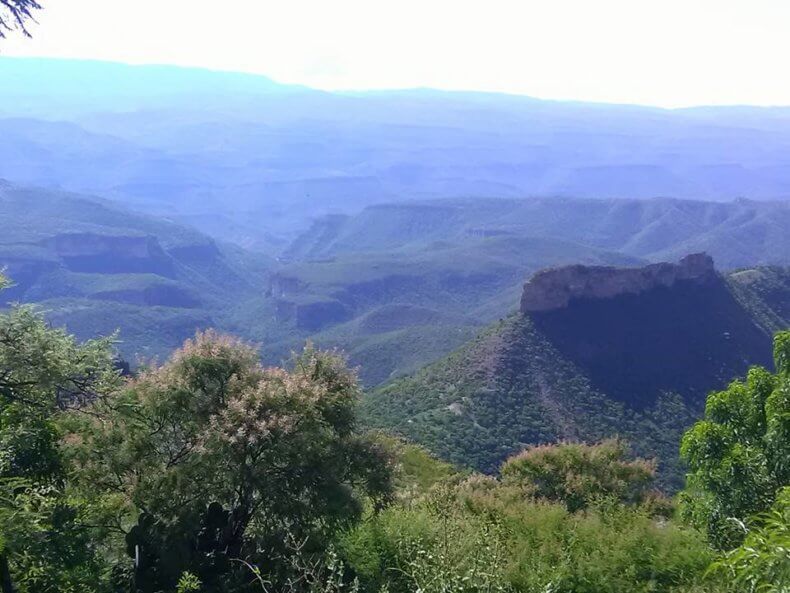
by Deep Green Resistance News Service | Sep 21, 2016 | Indigenous Autonomy, Reclamation & Expropriation
Featured image: The Wixárika community of San Sebastian Teponahuaxtlán or Wuaut+a is preparing to send 1,000 members to the remote Nayarit community of Huajimic to take back from the ranchers lands that the courts have ruled belong to the Wixárika. Photo from Facebook/San Sebastian Teponahuaxtlán.
by Tracy Barnett / Intercontinental Cry
A contingent of at least 1,000 indigenous Wixárika (Huichol) people in the Western Sierra Madre are gearing up to take back their lands after a legal decision in a decade-long land dispute with neighboring ranchers who have held the land for more than a century.
Ranchers who have been in possession of the 10,000 hectares in question for generations say the seizure is unlawful and that they will not hand over the land — setting the scene for a showdown that observers fear may end in violence.
Leaders of the Wixárika community of San Sebastian Teponahuaxtlán have announced their plans to accompany the authorities of the federal agricultural tribunal to carry out an enforcement action on the first parcel, a 184-hectare ranch in the state of Nayarit, on Sept. 22, and called on state and federal law enforcement officials to send police forces to prevent a conflict. Until the time of publication, neither the Nayarit nor the federal authorities had agreed to send police to maintain order, so both parties are hoping for the best but preparing for the worst.
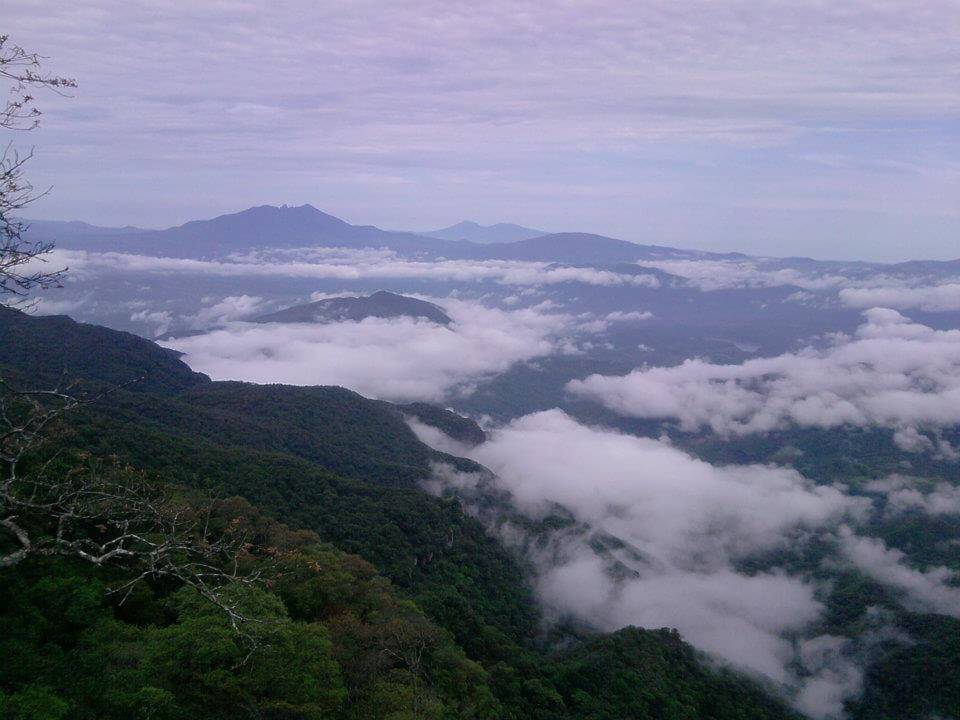
The Nayarit community of Huajimic in the municipality of La Yesca has a long tradition of ranching. Ranchers of Huajimic have titles to their land that date to 1906, but the courts have ruled that the Wixarika land claims go back to the Spanish land grant of 1717. Photo from Facebook/Huajmic, Nayarit.
“We’re hoping they’ll accept the decision which is now law: that they lost the trial. They had the opportunity to legally prove that they really had the documentation and they didn’t have it,” said Miguel Vázquez Torres, president of the communal lands commission of San Sebastian. He is aware of the potential for violence, he said, “but the community is not going to sit with its hands crossed. We are prepared.”
Ranchers have titles to the land that go back to the early 1900s — but San Sebastian has the original grant from the Spanish crown that dates to 1717, and is backed by a 1953 presidential resolution. In all, 10,000 hectares is at stake, for a total of 47 different claims. The agrarian court has ruled in favor of San Sebastian in 13 of those cases; the remainder are still in process.
Rosa Carmen Dominguez Macarty, an attorney representing some of the ranchers of Huajimic, disputes the version presented by Wixarika attorneys, saying that only two of the sentences are definitive, and that all the rest are still under appeal. The ranchers are appealing the 1953 presidential resolution, saying it is based on a document that is invalid.
“It’s a social injustice,” she said. “These are very simple people; they are fathers, they are mothers who work the land themselves, and that’s how they support their families. It would be really sad if through the government’s disregard, something unpleasant were to happen.”
Vázquez said that two families who have no land have already been granted permission by the community assembly to establish homesteads on the parcel and that the assembly plans to send a rotating contingent of community residents to stand guard for several months — “as long as it’s necessary so that the families can feel safe and comfortable.” The long-term plan, he said, is to establish another settlement in the area, as San Sebastian’s existing towns are becoming overcrowded.
Dominguez argued that the local inhabitants have worked the land for generations and turned it into a highly productive area. Local residents suspect the Huicholes have another ulterior motive for taking back the land, which they have never worked: to exploit the mineral deposits that supposedly lie beneath.

Members of the Wixarika community of San Sebastian Teponahuaxtlán protesting for land reform in Guadalajara in 2014. Photo from the Facebook/San Sebastian(Wuaut+a).
Complicating matters is that San Sebastian lies in the state of Jalisco, while the contested land lies in Nayarit, where the ranchers have been outspoken in their opposition to the court decision and have been organizing in resistance to the return of the land to the Wixárika.
“Jalisco vs. Nayarit: Blood will run,” screamed one headline in a Nayarit newspaper. Meanwhile, Nayarit Gov. Roberto Sandoval reportedly has sent messages of support to ranchers.
“The governor promised us that while he is in office, we would not have to turn over a single meter of land to the Huichols,” one of the landowners told local reporter Agustín Del Castillo of Milenio newspaper.
Indeed, it’s no accident that the conflict crosses state lines, according to anthropologist Paul Liffman, author of the book Huichol Territory and the Mexican Nation.
“In fact that’s the deep history of Jalisco and Nayarit,” Liffman said in a recent interview. “Nayarit was part of Jalisco, and it separated in 1917, in part for the ranchers who wanted more political autonomy and also wanted to kick out the Indians.”
During the early years of the 20th century, the government encouraged settlers to make land claims on apparently abandoned land. It was during that period that major encroachment began to occur on Wixárika land, and the courts granted titles based on the erroneous assumption (or pretext, as Liffman says) that the land was unoccupied.
Tensions have flared periodically since the land was taken but the Wixárika had no legal recourse until the government created an agrarian court system in the 1990s, said Ruben Avila Tena, the attorney representing the community of San Sebastian. Soon afterwards that community began a legal process of reclaiming its land.
Jalisco law enforcement has agreed to be present, but only up to the state line; thus far the Wixárika leadership has received no such assurances from the Nayarit authorities, nor from the federal government.
“I’m not sure what the Jalisco police can do, besides cheering them on from the other side of the border,” commented Avila Tena. “It’s actually a very worrisome situation.”
Avila said sources in the Agrarian Tribunal have told them that the Nayarit police have no intention of supporting the Wixárika on Sept. 22. Agrarian Magistrate Aldo Saul Muñoz López spoke to this reporter by telephone but said he could not grant an interview by telephone, only in person in the Tribunal regional offices in Tepic, Nayarit.
“We did what corresponds to us as a federal tribunal, we notified all of the relevant authorities of Nayarit. If they don’t respond, it’s something that escapes my authority,” said Muñoz López, but would not give further information by phone.
Liffman likened the current conflict in San Sebastian with one that arose in the 1950s under the Huichol leader Pedro de Haro. Haro built a movement that ultimately procured the 1953 presidential resolution confirming that San Sebastian was the legal owner of the land. But as in the present case, the government didn’t provide any enforcement mechanism, and the local residents refused to give up the land. A band of armed Huichols took the matter into their own hands and marched to the Canyon of Camotlán, where they reportedly burned down a farm, drove out local residents and reclaimed the land.
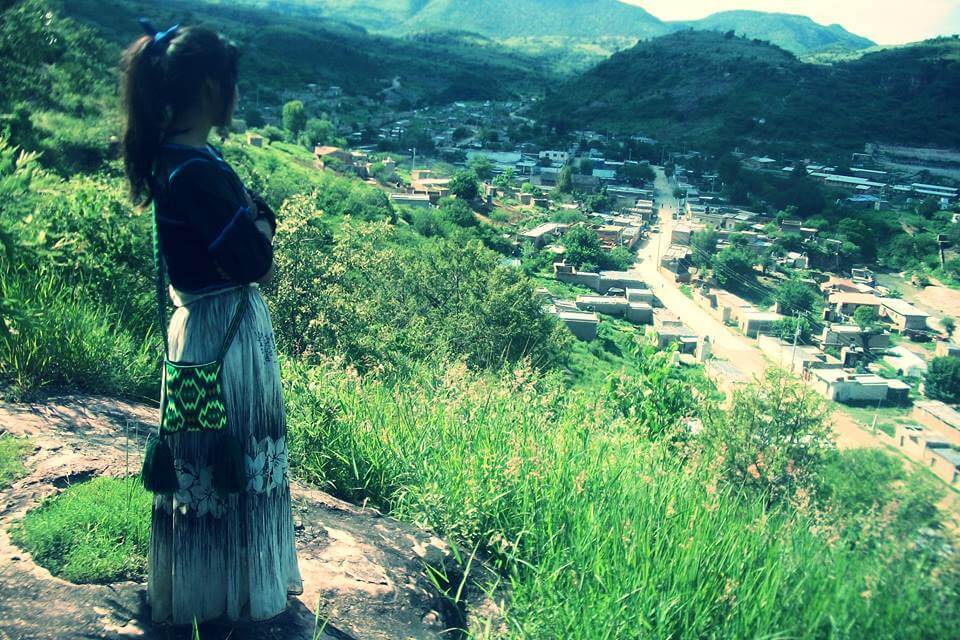
Photo from the Facebook pages of the community of San Sebastian (Wuaut+a).
Santos de la Cruz Carrillo, a Wixárika leader and also an attorney on San Sebastian’s legal team, said the community has been urging the federal authorities to attend to this case for five years under a program that would offer financial compensation to the current landholders.
“It’s been five years since the community of San Sebastian asked the federal government to attend to this situation, to support the landholders with compensation”, said de la Cruz. “But the ranchers showed no interest in the compensation; they always said they want the land, so the community chose to take possession.”
Finally, in a meeting in March of this year, an official with that program told San Sebastian authorities that there was no money to pay restitution to the ranchers. That’s when they made the decision to move ahead with the process of retaking the lands, said Avila.
The Wixárika authorities have done everything in their power to seek compensation for the ranchers in the hope that a conflict could be avoided, said Avila. “This case was decided in their favor more than two years ago,” he stressed. “The community didn’t want it to be enforced like this, they were trying to get the federal government to indemnify the landholders. When they couldn’t do that anymore, they said, it can’t be helped, we will have to ask the tribunal to enforce the law.”
Liffman warned that the situation was not to be taken lightly; the area has changed radically since the times of Pedro de Haro, he said, with a significant amount of drug production now occurring throughout the territory.
“The region has become much more heavily armed,” he said. “San Sebastian has been the most violently disputed area in the sierra over the past several years…. it’s big-scale transnational narcos now, it’s not just some ranchers with pistols on their belts. So if it does come to that, it could be a bloodbath.”
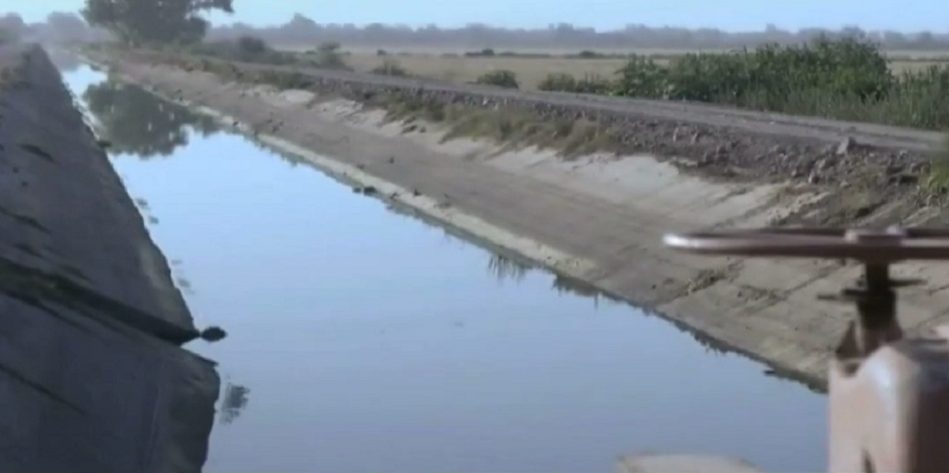
by Deep Green Resistance News Service | Aug 21, 2016 | Colonialism & Conquest
By Intercontinental Cry
In this 60-minute film, the Mexican writer, novelist and political activist Paco Taibo II travels to the territory of the Yaqui Peoples to remember the longest-running armed struggle in Mexico’s history (1867-1909); a righteous struggle that was dragged to its end, in Paco Taibo’s own words, through a malignant ten year program of “Systematic military destruction” that used “multiple mechanisms of violence, torture, mass murder [and] enslavement of a community.”
Despite the brutal hardship, the 42-year war immortalized the will of the Yaqui Nation for all days to come. Even now, more than 100 years after this forgotten history the Yaqui continue to struggle for their most basic human rights.
Today, the Yaqui may no longer carry arms, nevertheless, their struggle–like that of all Indigenous Peoples and Nations around the world–is one that can only truly end in Justice.
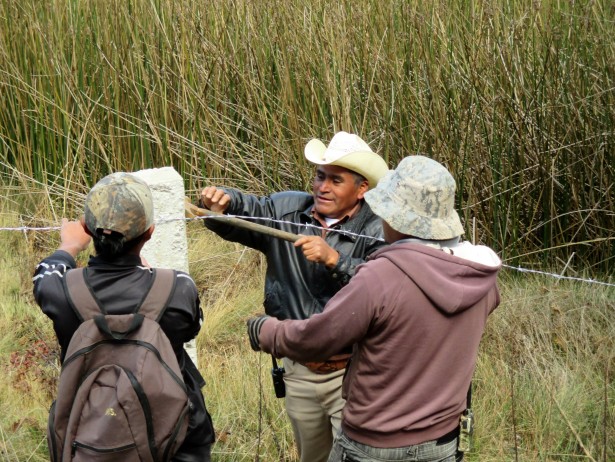
by Deep Green Resistance News Service | Feb 28, 2016 | Biodiversity & Habitat Destruction, Indirect Action
Featured image: Candelaria residents erect a fence around the Suyul Lagoon to help protect it from intruders. (Waging Nonviolence/Sandra Cuffe)
By Sandra Cuffe / Waging Nonviolence
The reeds and grasses are as tall as Sebastián Pérez Méndez, if not taller. The vegetation is so thick it’s hard to see the water in the Suyul Lagoon that he and other local Maya Tzotzil residents are working hard to protect. Pérez Méndez crosses the road to point out where aquatic plants serve as a natural filter for the water as it flows out the lagoon, located in the highlands of Chiapas, in southern Mexico.
“The water is under threat,” he said. Pérez Méndez is the top authority of the Candelaria ejido, a tract of communally-held land in the municipality of San Cristóbal de las Casas. “We’re not going to allow it.”
Communities in Chiapas are organizing to protect the Suyul Lagoon and communal lands from a planned multi-lane highway between the city of San Cristóbal de las Casas and Palenque, where Mayan ruins are a popular tourist destination. Candelaria residents continue to take action locally to protect the lagoon. They also traveled from community to community along the proposed highway route, forming a united movement opposing the project.
It all started back in 2014 when government officials showed up in Candelaria looking for ejido authorities, including Pérez Méndez’ predecessor. It was the first residents had heard about plans for the highway. The indigenous inhabitants had not been consulted and were not shown detailed plans.
“They realized that [the government officials] were only seeking signatures,” Pérez Méndez said.
No one person or group is authorized to make a decision that would affect ejido lands, however, and there are strict conditions in place to ensure elected ejido leaders are accountable to members, he explained. An extraordinary assembly was held to discuss the highway project.
The Candelaria ejido was established in 1935, a year after a new agrarian law enacted during the Lázaro Cárdenas administration led to widespread land reform throughout Mexico. More than 2,000 people live in the 1,600-hectare ejido, and more than 800 of them are ejidatarios — legally recognized communal land holders whose rights have been passed down for generations. Only ejidatarios as a whole have the power to make decisions on issues like the highway project.
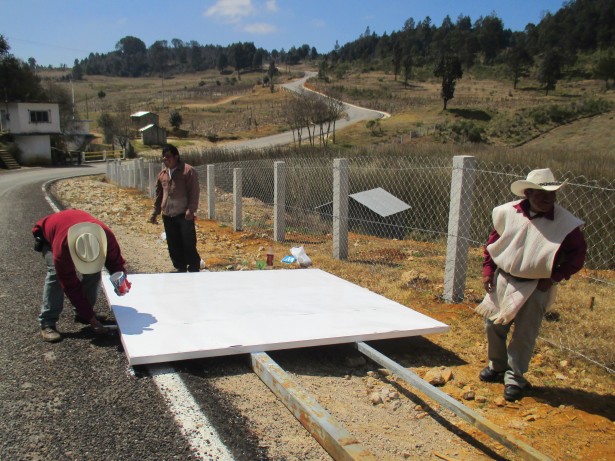
Candelaria residents paint over graffiti to fix up a roadside sign proclaiming their opposition to the highway project. (Waging Nonviolence/Sandra Cuffe)
“The ejido said no,” said Guadalupe Moshan, who works for the Fray Bartolomé de Las Casas Human Rights Center, or FrayBa, supporting Candelaria and other communities in Chiapas. “They didn’t sign.”
Candelaria leaders sought assistance from FrayBa in 2014, after they were approached by government officials and pressured to sign a document indicating their consent to the highway project that would involve a 60-meter-wide easement through communally-held lands. Officials told community members that the highway was already approved and that they would be well compensated, but that there would consequences if they refused to sign, Moshan said.
“They told them they would suspend government programs and services,” she explained. In the days following the extraordinary ejido assembly rejecting the project, there was unusual activity in the area, according to Moshan. Helicopters flew over theejido, unknown individuals entered at night, and trees were marked, she said.
Protecting the Suyul Lagoon remains at the heart of Candelaria’s opposition to the planned highway. The lagoon provides potable water not only for Candelaria, but also for several nearby communities, said ejido council secretary Juan Octavio Gómez. Aside from the highway itself, project plans eventually shown to the community leaders include a proposed eco-tourism complex right next to the lagoon. That isn’t in the communities’ interest, Gómez explained.
“Water is life. We can’t live without it,” he said. “Without this lagoon, we don’t have another option for water.”
Fed by a natural spring, the Suyul Lagoon never runs dry. Local residents are careful to protect the water and lands in the ejido, where the majority of residents live from subsistence agriculture, sheep rearing and carpentry. They engage in community reforestation, but have plans to plant more trees, Gómez said.
The Suyul Lagoon is also sacred to local Maya Tzotzil. Ceremonies held every three years in its honor involve rituals, offerings, music and dance.
“It is said that it’s the navel of Mother Earth,” Pérez Méndez said.
Candelaria residents didn’t sit back and relax after rejecting the highway project in their extraordinary assembly. They have been organizing ever since. The Suyul Lagoon lies just outside the Candelaria ejido, but it belongs to ejidatarios by way of an agreement with the supportive land owner. Aside from the highway project and potential eco-tourism complex, the lagoon has caught the attention of companies, whose representatives have turned up in the area expressing interest in establishing a bottling plant.
It’s cold in February up in the highlands, but community members have been out all day, erecting a fence around the Suyul Lagoon to protect it from intruders. White fence posts are visible under the treeline across the sea of reeds. Like so many other local initiatives, fence materials are collectively financed by the ejido and the labor is all voluntary, communal work.
While residents continue stringing barbed wire from post to post, others take paintbrushes to one of their roadside signs. Locals have erected large signs next to roads in and around their ejido, announcing their opposition to the tourist highway.
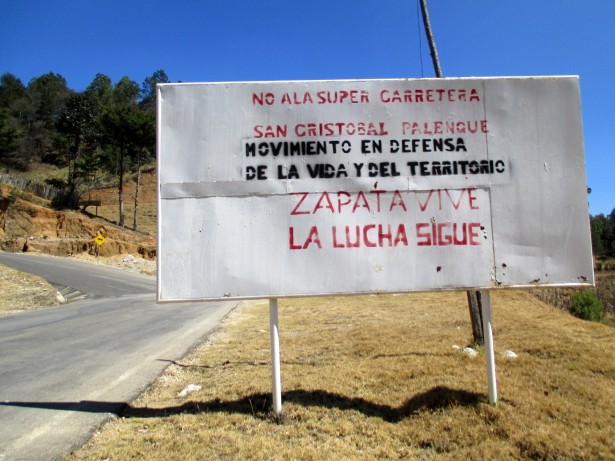
A sign along the road leading to Candelaria informs passers-by of opposition to the planned super-highway. (Waging Nonviolence/Sandra Cuffe)
“We’re also already organized with the other communities,” Pérez Méndez said. “All the communities reject the super-highway.”
After they were approached by government officials, Candelaria ejido residents traveled from community to community along the entire planned highway route. Some communities hadn’t heard of the project at all, while others said they were pressured into signing documents indicating their consent, Pérez Méndez said. As a result of Candelaria’s visits, community organizing along the highway route led to the formation of a united front of opposition, the Movement in Defense of Life and Territory.
Candelaria also recently got together with other indigenous communities in the highlands to issue a joint statement rejecting the tourist super-highway and a host of other government and corporate projects and policies.
“Our ancestors, our grandfathers and our grandmothers have always taken care of these blessed lands, and now it’s our turn to [not only take] care of the lands, but also to defend them,” reads the February 10 communiqué.
“The neoliberal capitalist system, in its ambition to exploit natural assets, invades our lands,” the statement continues. “The government and transnational companies are violently imposing their mega-projects.”
Back along the edge of the Suyul Lagoon, Candelaria residents continue to string barbed wire from post to post. They’ve been at it for a while now, according to Pérez Méndez, but they’ve now stepped up their efforts and hope to finish the fence by the end of the month.
Pérez Méndez surveys the progress, protected from the unrelenting sun and icy wind by his hat and white sheep’s wool tunic. He becomes pensive when asked if he thinks communities will be able to defeat the highway project.
“Yes,” the ejido leader said, after giving it some thought. “We can stop it.”










